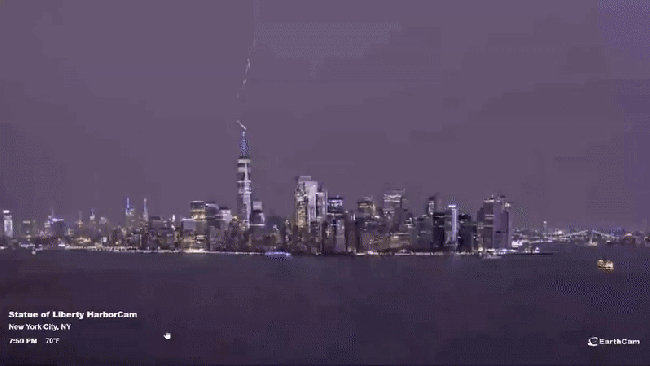As thunderstorms swept into the Northeast on Saturday night, the northern edge of the storms skimmed through the Big Apple.
As thunderstorms swept into the Northeast on Saturday night, the northern edge of the storms skimmed through the Big Apple.

A series of lightning strikes spidered across the New York City skyline the evening of Saturday, April 1, a few of which stretched from the World Trade Center into the clouds above in a dazzling display.
The upside-down lightning was no April Fool’s joke as thunderstorms moved into the Northeast on Saturday evening, the northern edge of the storms clipping past the Big Apple.
Flashes like the ones seen Saturday evening are called “ground to cloud” lightning strikes and often originate at the top of man-made buildings, according to AccuWeather Senior Weather Editor Jesse Ferrell.

Nature’s power on display! ⚡ A lightning bolt struck One World Trade Center over the weekend, which was captured by #EarthCam from multiple angles! Head to https://t.co/w3DpNuJ5AF to watch your favorite cameras across the globe live – You never know what you’ll see! pic.twitter.com/nDBEBfsYWg
— EarthCam (@EarthCam) April 3, 2023
“New York City was on the northern edge of the storms, so there wasn’t a lot of lightning,” Ferrell said. “Only two cloud-to-ground lightning events were detected by Vaisala’s lightning sensors in Manhattan, but strikes that are initiated by towers wouldn’t appear in that count.”
This wasn’t the skyscraper’s first encounter with lightning, either. Between 2015 and 2020, lightning struck the One World Trade Center 189 times, ranking number two in the nation for major city towers.

The storm that spawned the lightning was a part of the same system that left over two dozen dead in the South and Midwest on Friday. According to AccuWeather Senior Meteorologist Dave Dombek, it moved eastward in two parts, the first of which was mostly rain. The second half, however, was more reminiscent of the system’s history of destruction.
“The main piece of that system came eastward with a pool of colder air aloft and a lot more instability,” Dombek said. “Things got very active in a hurry late Saturday and Saturday evening.”

The second half of the storms turned severe, and there was at least one storm-related death in Delaware.
A confirmed tornado was located near Bridgeville in Sussex County, Delaware, shortly after 6 p.m. local time, moving east at 50 mph, according to the National Weather Service. Following the destruction, Leonard DeMalto, a spokesperson for the Delaware State Police, told ABC News that one person was confirmed dead after a home collapsed amid the storms.
As of 8 AM Monday, here is a summary of where we currently stand with storm damage assessment. 6 tornadoes have been confirmed so far and additional surveys are planned for today. More details are in the linked public statement: https://t.co/C1CBSEeCrb #NJwx #DEwx #PAwx pic.twitter.com/oEP8tHXPys
— NWS Mount Holly (@NWS_MountHolly) April 3, 2023
The NWS office in Mount Holly, New Jersey, confirmed at least five other tornadoes and said there are three damage sites still under investigation.
Only two tornadoes have been rated — one that started in Cinnaminson and ended in Moorestown, New Jersey, and a second that tracked from Wrightstown Township to Newtown, Pennsylvania. Both were listed at EF1 strength with estimated maximum winds of 100 and 105 mph, respectively.
Produced in association with AccuWeather

